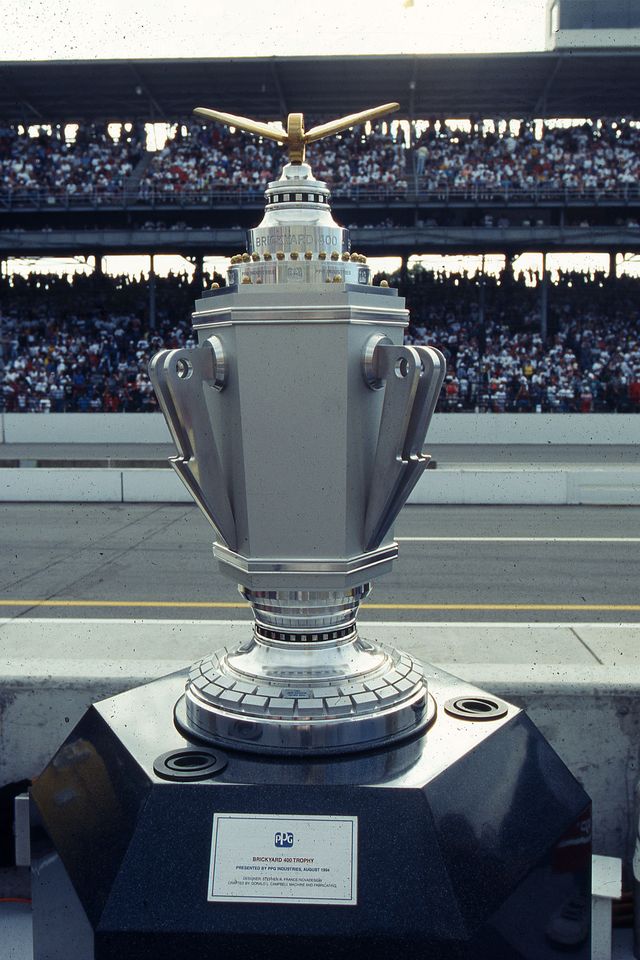How Dale Earnhardt Toppled Jeff Gordon and the Elements at Second Brickyard 400

- Jeff Gordon had won the first-ever Cup race at the track in 1994 as an overflow crowd looked on.
- In 1995, race day was almost as much about watching the skies for rain as it was watching to see if Jeff Gordon could repeat his 1994 triumph.
- Dale Earnhardt, who had targeted the inaugural Brickyard 400 the previous season as a race he desperately wanted to win, scored this time.
There are many adjectives—pick one—that could be used to describe the first Brickyard 400 in 1994: Historic. Unprecedented. Dramatic. Spectacular. Scintillating.
There is one adjective that could be used to describe the second Brickyard 400 in 1995: Wet.
After NASCAR and Indianapolis Motor Speedway officials brokered the deal that brought the Cup Series to the world’s most famous speedway in 1994—and after the amazing success of that weekend, there was much anticipation for the stock cars’ second visit to the Brickyard the next year.
Jeff Gordon had won the first-ever Cup race at the track the previous season as an overflow crowd—ticket scalpers were quite busy as seats in the IMS grandstands were cherished for the historic afternoon—looked on. Despite the thunder of the NASCAR stockers, cheers for Gordon, an Indiana boy who had reached racing’s heights, could be heard across the grandstands as he led 93 laps and swept to a .53-second win over Brett Bodine.
Another full house was expected Aug. 5, 1995, when Cup drivers returned to IMS. But that ugly word that no one in or around a racetrack wants to hear raised its head for the weekend: Rain.
In mid-week, Hurricane Erin made landfall in Florida, and the remains of the downgraded storm moved into the Midwest during the weekend, soaking the speedway on Friday and Saturday, race day. The weather eliminated a scheduled round of morning practice and second-session qualifying Friday, and there was more rain Friday night. The Saturday forecast promised more ugliness.
As teams and fans began arriving at the track for race morning, they were greeted with gray skies and more rain, and, by mid-morning, many in the garage area had decided that there was virtually no chance the race would be held as scheduled on Saturday.
Many fans waited in muddy parking lots hoping for a green light for racing, but thousands eventually left the speedway area in the afternoon.
Traffic in the track’s massive infield also was busy as some individuals working the event, including more than a few journalists, packed their things and headed toward area hotels, convinced that rain would be the day’s only winner.
NASCAR officials were much more patient with weather conditions in those days, holding out hope for a “window” that would allow a green flag. On many similar occasions at too many tracks, that opening never appeared, and teams, officials and fans essentially wasted a day waiting for nothing. Eventually, NASCAR began taking weather forecasts—and the now-dominating radar—much more seriously and moved to an approach that allows for the postponing of races early on race day if there appears virtually no chance skies will clear.
NASCAR’s patience paid off that day in Indianapolis, however. Just when it seemed almost too late for racing, the rain moved out of the area, and track-drying procedures began. Fans who had driven miles from the racetrack executed U-turns and returned to the grandstands.
Late in the afternoon (almost 5:30 p.m. Eastern time), with hours of daylight remaining, the race finally began.
Dale Earnhardt, who had targeted the inaugural Brickyard 400 the previous season as a race he desperately wanted to win, scored this time. He held a comfortable lead over the closing laps and beat both the rest of the field and darkness.
Famously, Earnhardt declared himself “the first man” to win the 400, a playful jab at Gordon.
In reality, almost everyone involved was a winner on a day that began under umbrellas and ended—surprisingly—with 400 miles in the books.
Now, this week, the Cup Series rolls into Indy again, with a return to the speedway’s road course. All indications are that Cup drivers will return to the oval in 2024, a welcome switch. Too early to worry about long-range forecasts.
Read the full article here









